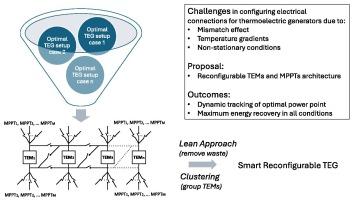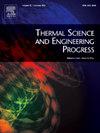在非稳态条件下最大化热电发电机能量收集的可重构架构
IF 5.1
3区 工程技术
Q2 ENERGY & FUELS
引用次数: 0
摘要
热电发生器 (TEG) 的使用已在能量收集的众多应用领域中激增。随着越来越多的模块被用于回收更多的能量,它们之间的温度失配也随之增加。这导致每个模块在不同的最大功率点上运行,从而降低了整个系统的效率。此外,在汽车等动态应用中,热电发电机的温度并不恒定,最大功率点也会相应变化。固定架构无法应对这些波动情况。因此,本文介绍了一种可重新配置的架构,能够在任何特定时刻利用最大能量,与固定架构相比,提高了能量回收率。本文采用了优化技术、精益方法和聚类方法来有效设计可重新配置的 TEG,从而能够修改 TEG 模块内部的电气连接和最大功率点跟踪 (MPPT) 模块的数量。本文介绍了一个使用案例,将可重新配置的 TEG 与固定但经过优化的 TEG 配置在混合驱动模式下进行比较。在这一具体案例中,结果表明可重构 TEG 在混合场景下使用两个 MPPT 的动态环境中实现了更高的性能,效率达到 96.3%,能量回收率提高了 0.29%。本文章由计算机程序翻译,如有差异,请以英文原文为准。

A reconfigurable architecture for maximizing energy harvesting of thermoelectric generators in non-stationary conditions
The use of Thermoelectric Generators (TEGs) has proliferated across a multitude of applications for energy harvesting. As more modules are employed to recover greater amounts of energy, the temperature mismatch between them increases. This results in each module operating at a distinct maximum power point, thereby reducing the overall system efficiency. Furthermore, in dynamic applications such as automotive scenarios, the temperatures of the thermoelectric generators are not constant, and the maximum power point accordingly shifts. A fixed architecture is unable to cope with these fluctuating situations. Therefore, this paper introduces a reconfigurable architecture capable of harnessing maximum energy at any given moment, improving energy recovery compared to a fixed architecture. Optimization techniques, lean methodologies, and clustering approaches are employed to efficiently design the reconfigurable TEG, which enables modification of the electrical connections inside the TEG modules and the number of Maximum Power Point Tracking (MPPT) modules. A use case is presented where the reconfigurable TEG is compared with fixed, yet optimized, TEG configurations under mixed driving modes. In this specific case, the results demonstrate that the reconfigurable TEG achieves enhanced performance in dynamic environments with two MPPTs under mixed scenarios, reaching an efficiency of 96.3% and a 0.29% improvement in energy recovery.
求助全文
通过发布文献求助,成功后即可免费获取论文全文。
去求助
来源期刊

Thermal Science and Engineering Progress
Chemical Engineering-Fluid Flow and Transfer Processes
CiteScore
7.20
自引率
10.40%
发文量
327
审稿时长
41 days
期刊介绍:
Thermal Science and Engineering Progress (TSEP) publishes original, high-quality research articles that span activities ranging from fundamental scientific research and discussion of the more controversial thermodynamic theories, to developments in thermal engineering that are in many instances examples of the way scientists and engineers are addressing the challenges facing a growing population – smart cities and global warming – maximising thermodynamic efficiencies and minimising all heat losses. It is intended that these will be of current relevance and interest to industry, academia and other practitioners. It is evident that many specialised journals in thermal and, to some extent, in fluid disciplines tend to focus on topics that can be classified as fundamental in nature, or are ‘applied’ and near-market. Thermal Science and Engineering Progress will bridge the gap between these two areas, allowing authors to make an easy choice, should they or a journal editor feel that their papers are ‘out of scope’ when considering other journals. The range of topics covered by Thermal Science and Engineering Progress addresses the rapid rate of development being made in thermal transfer processes as they affect traditional fields, and important growth in the topical research areas of aerospace, thermal biological and medical systems, electronics and nano-technologies, renewable energy systems, food production (including agriculture), and the need to minimise man-made thermal impacts on climate change. Review articles on appropriate topics for TSEP are encouraged, although until TSEP is fully established, these will be limited in number. Before submitting such articles, please contact one of the Editors, or a member of the Editorial Advisory Board with an outline of your proposal and your expertise in the area of your review.
 求助内容:
求助内容: 应助结果提醒方式:
应助结果提醒方式:


